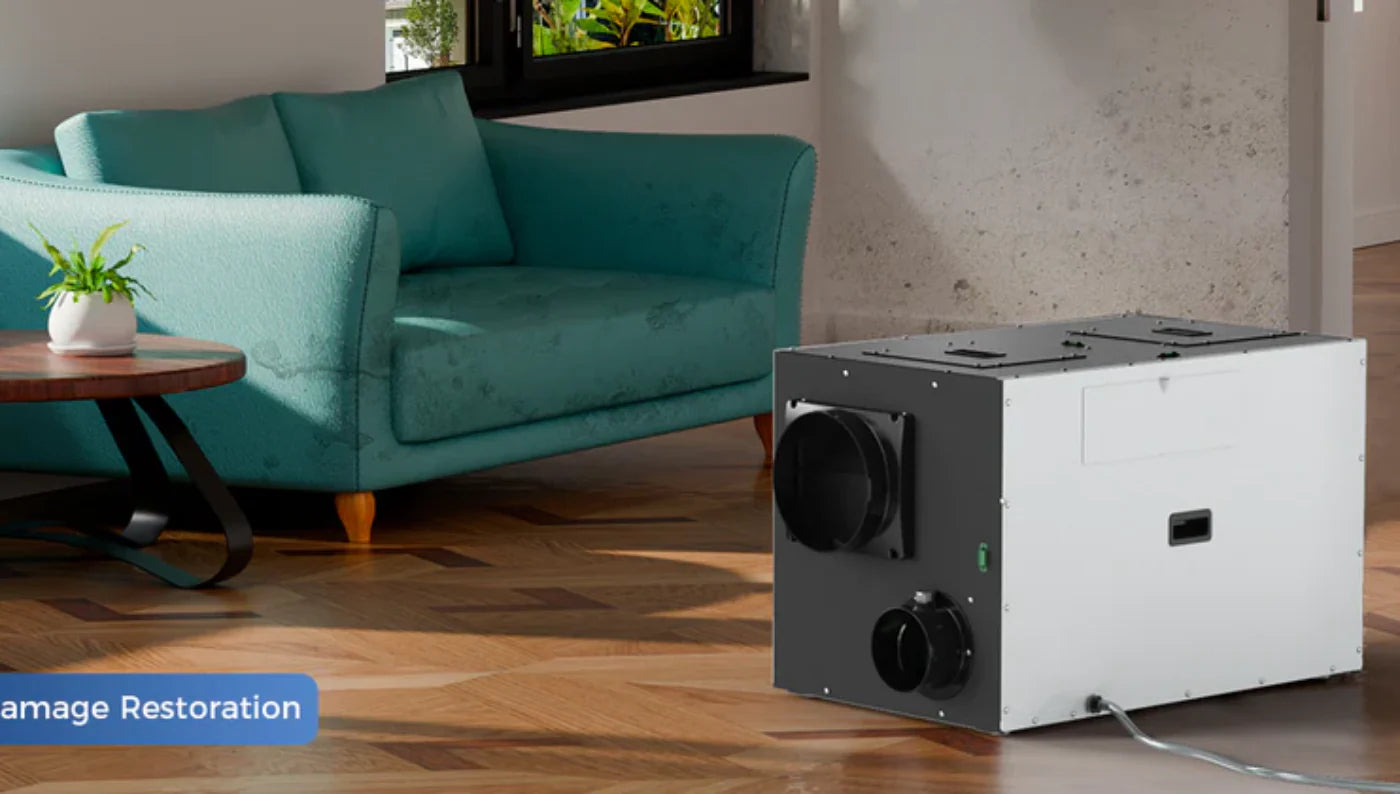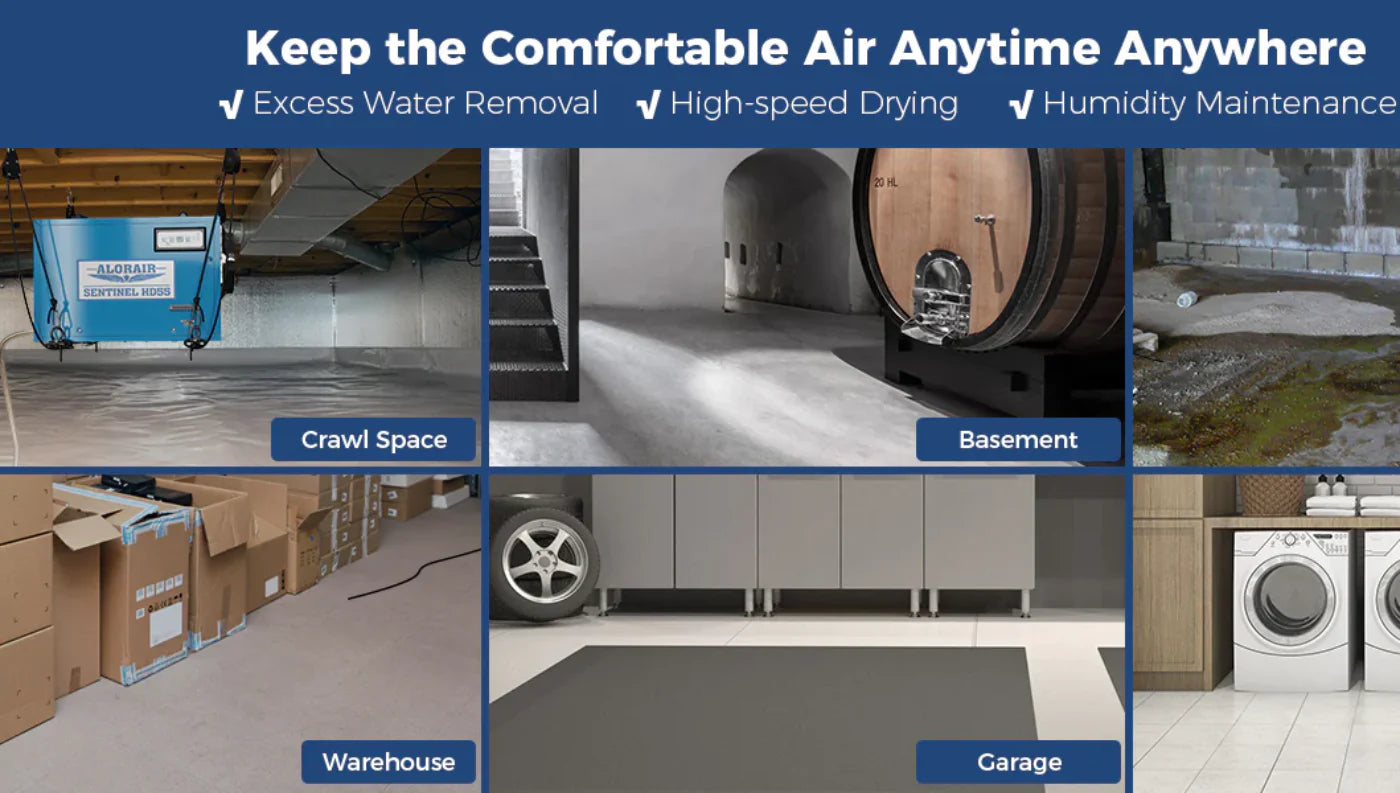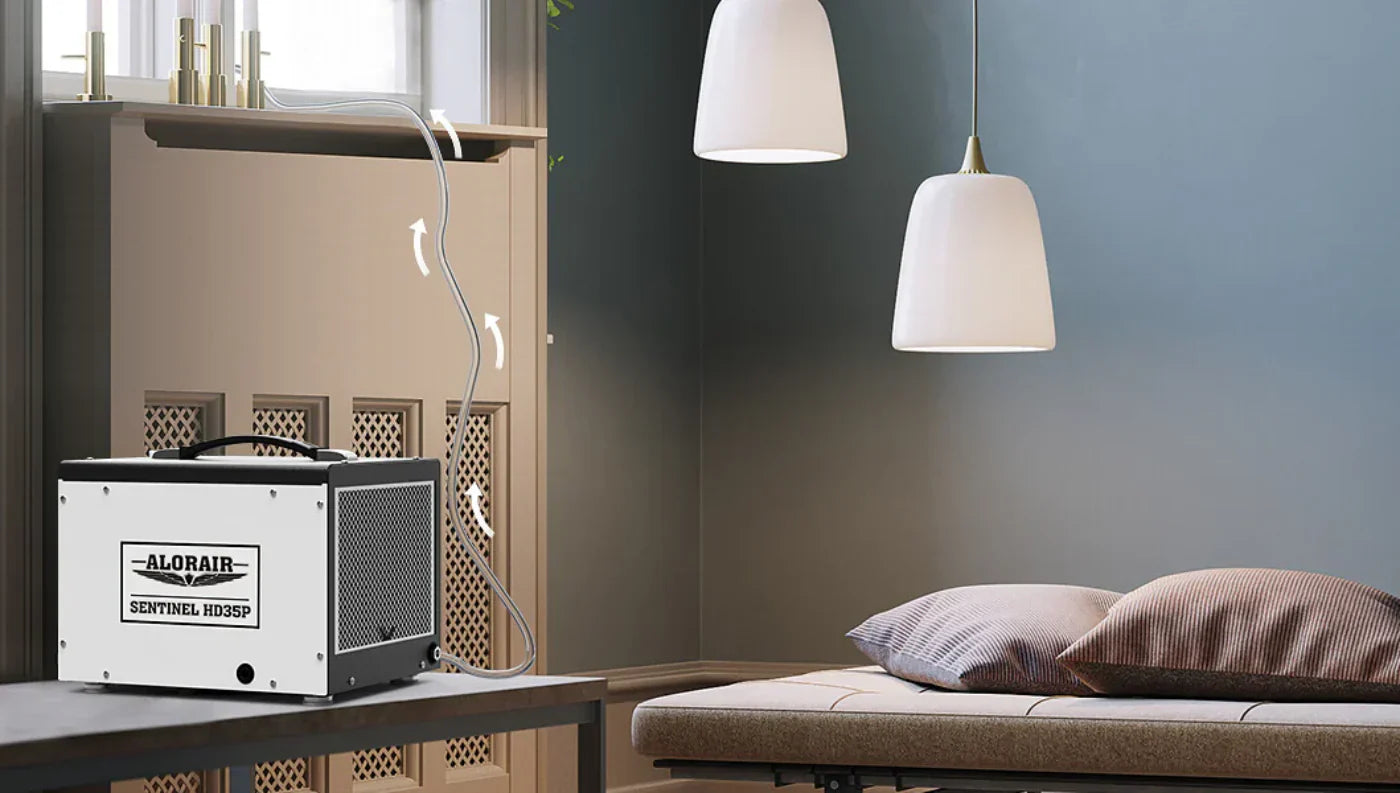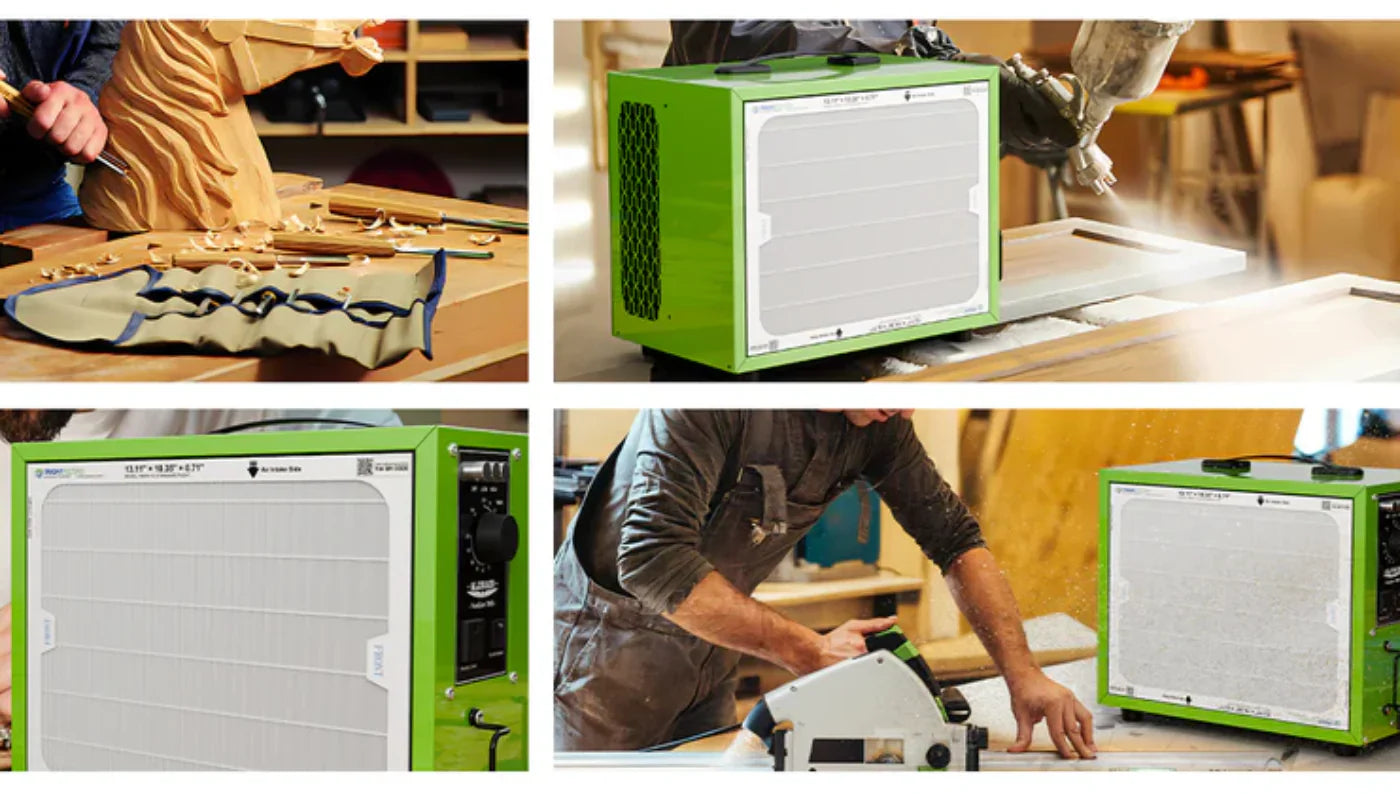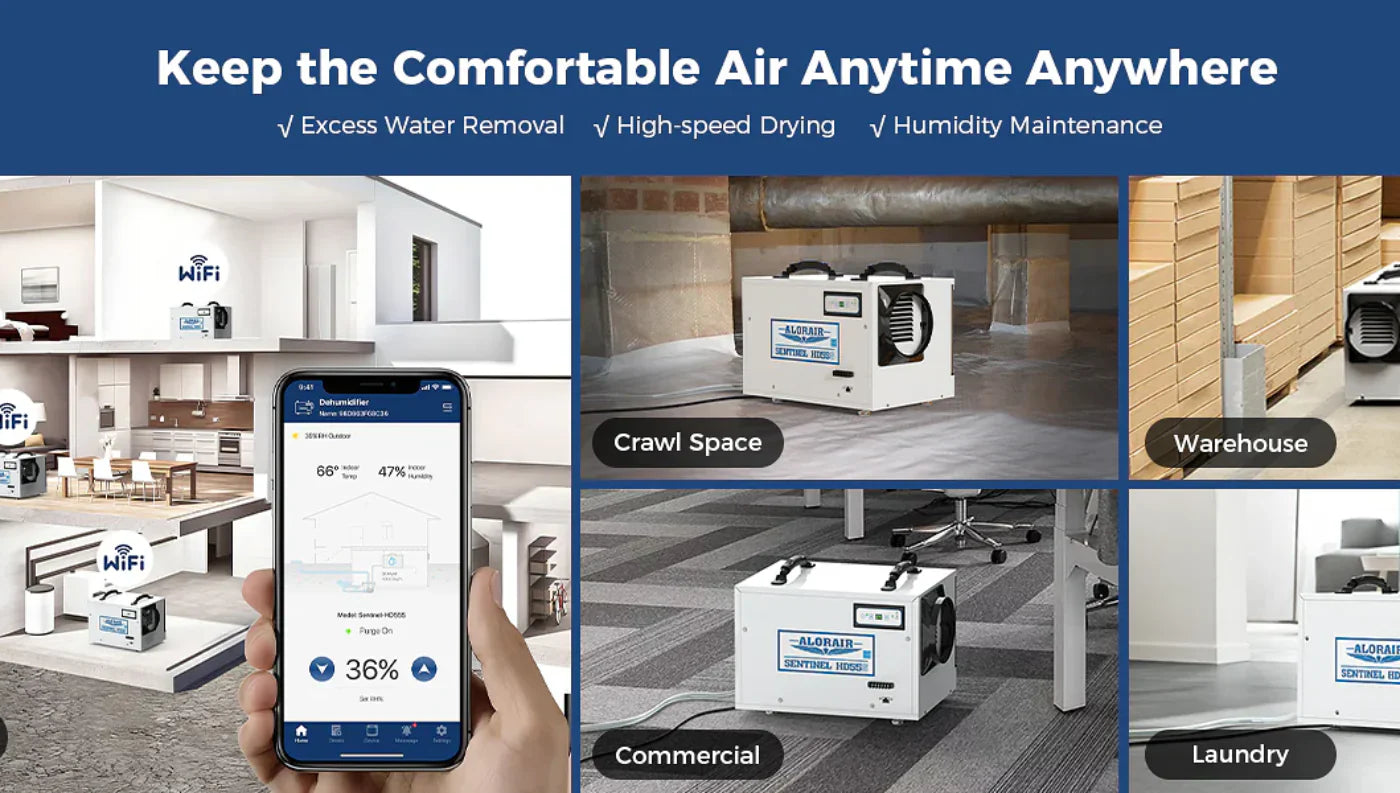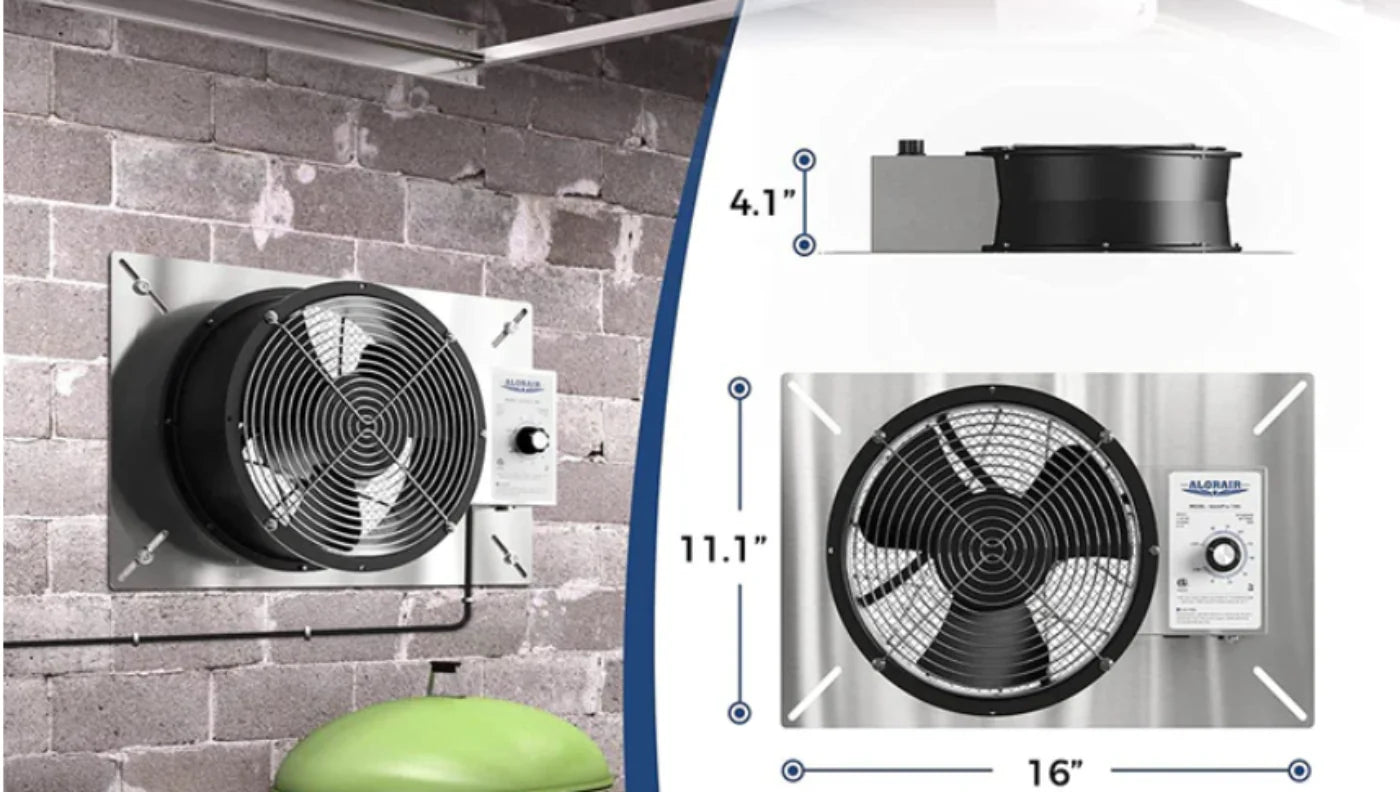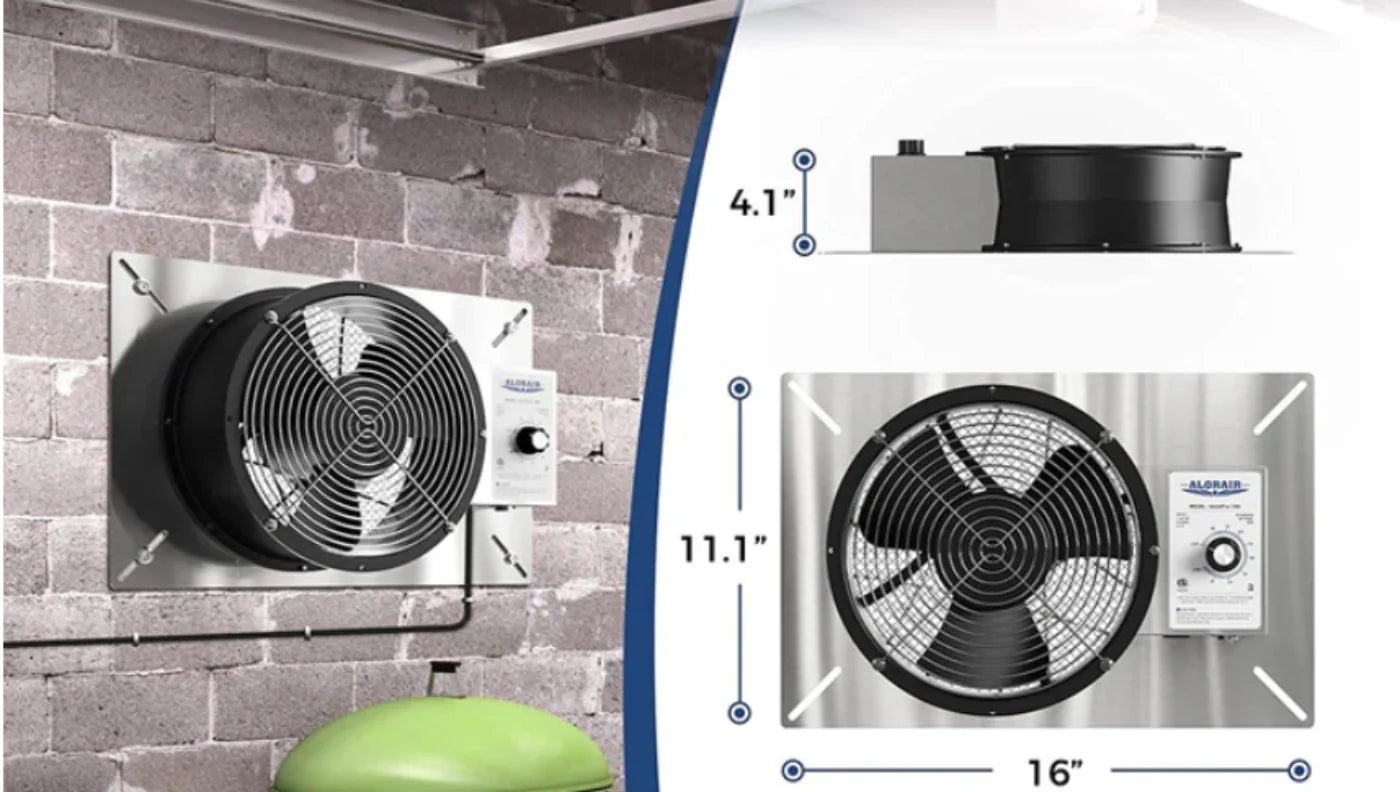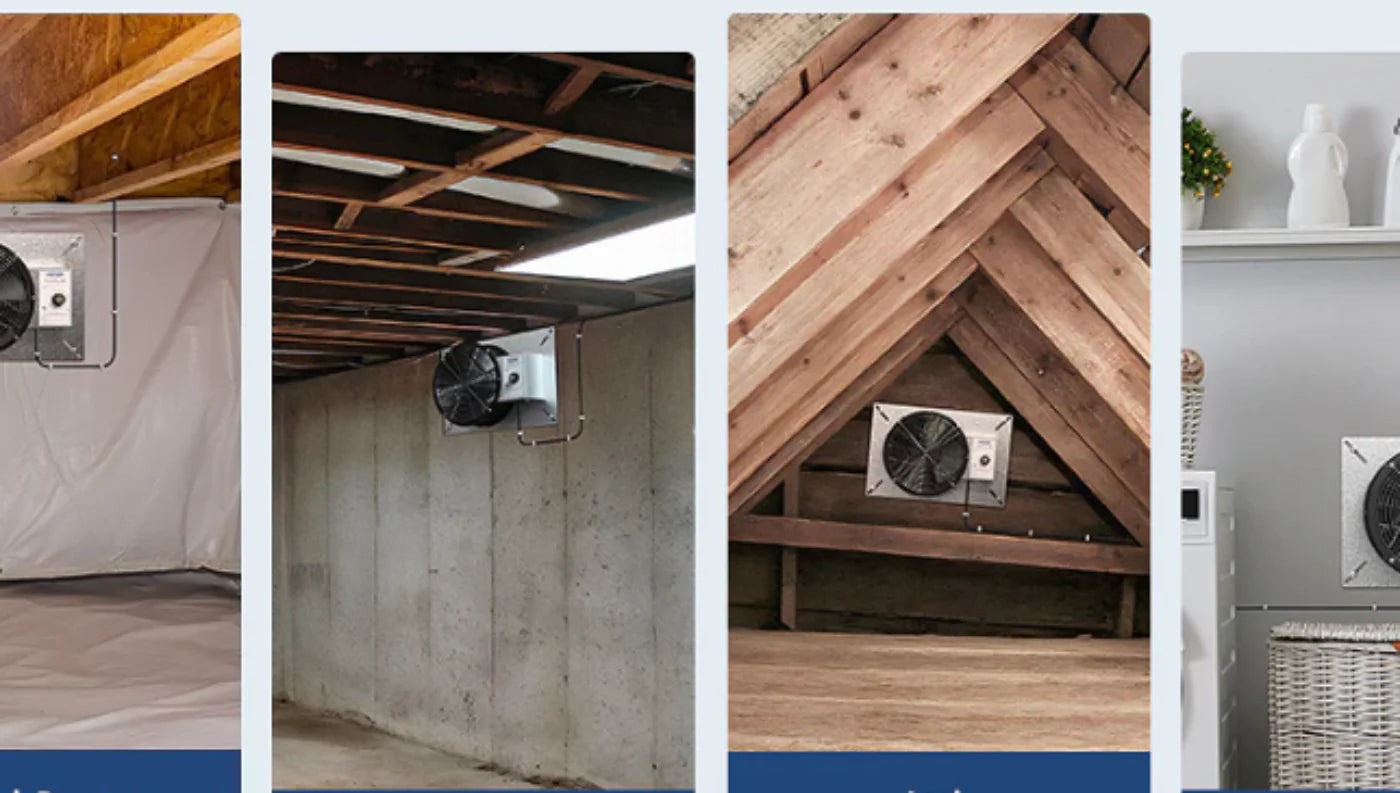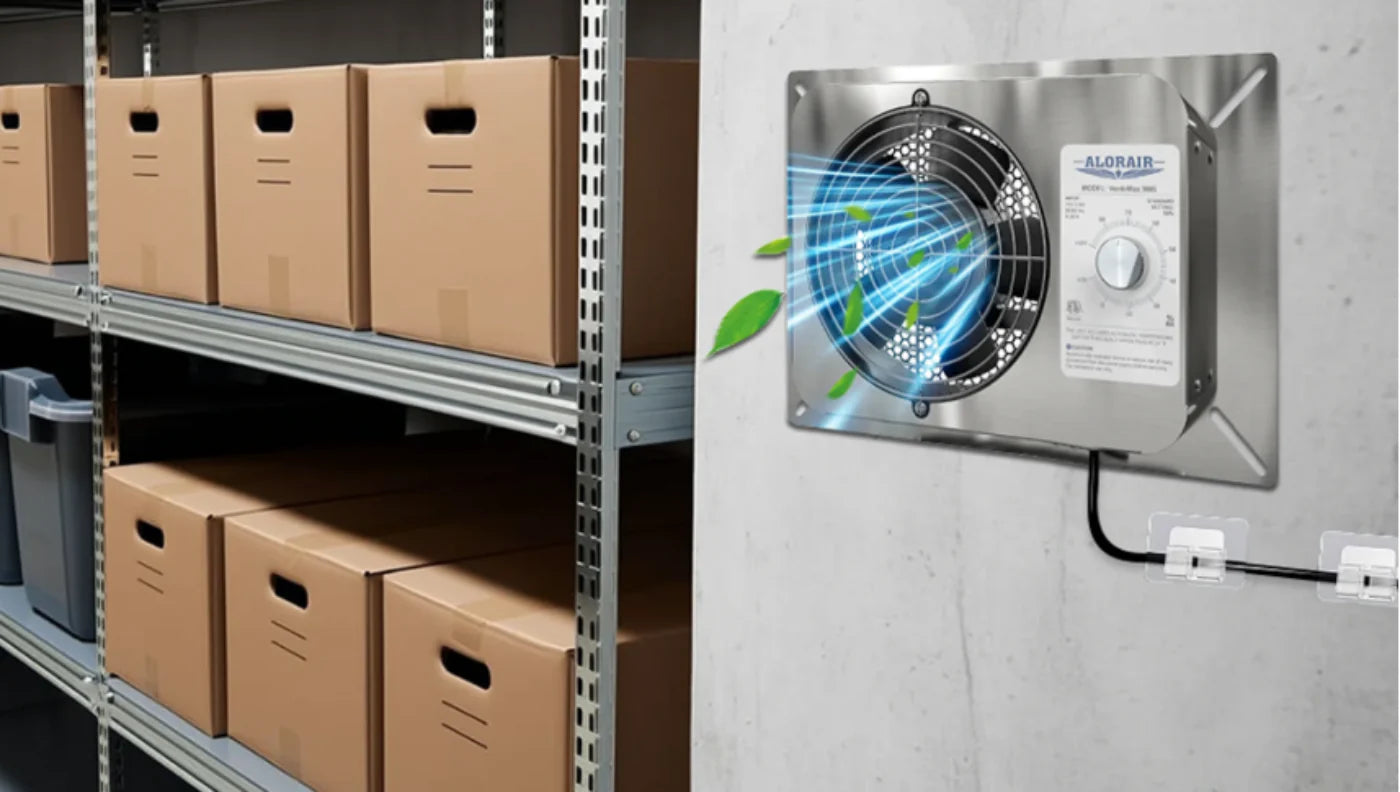If your home feels sticky even when the AC is on, or indoor humidity keeps drifting above 55–60%, a whole-house dehumidifier is the fix that actually holds a steady number. This guide keeps things very simple. We’ll show you how whole-house units work, who they’re for, and which models fit best by home size and setup.
You’ll also get clear pointers on ducted vs. ductless installs, what “HVAC-ready” means, and how to size without overthinking it.
Our picks focus on quiet operation, reliable humidity control around 45–55% RH, and practical ownership: easy drainage, filter access, and solid warranties. When in doubt, choose the option that you can place and service easily, and that matches your square footage with a bit of headroom for hot, humid months.
How a Whole-House Dehumidifier Helps (in plain words)
Your AC dehumidifies only while it’s cooling. On mild but humid days, the AC may hardly run, leaving the house damp. A whole-house dehumidifier runs any time humidity is high, regardless of temperature. It pulls air through a cold coil, removes water, and sends dry air back into the duct system or into the space directly.
Set it once—typically 50% RH—and it holds that number across seasons, protecting wood floors, cabinets, and indoor air quality. You can duct these units into your existing HVAC, or operate them as a stand-alone central system. Either way, your goal is stable RH with minimum fuss.
Ducted vs. Ductless vs. HVAC-Ready
Ducted means the dehumidifier connects to supply or return ducts so dry air distributes through the home. This is the most even and efficient approach, especially for multi-room layouts.
Ductless means the unit draws air from a return grille and supplies directly into a central area without tying into HVAC. It’s a cleaner install when you can’t modify existing ductwork but still want whole-home impact. Placement matters for good mixing.
HVAC-ready means the model is designed to integrate with your furnace/air handler. The preferred configuration is a dedicated return to the dehumidifier and a supply tie-in downstream of the AC coil, so dry air blends into the supply trunk with minimal re-evaporation and without relying on the AC to run.
Quick Sizing Made Easy
Start with conditioned square footage and moisture load. In average U.S. climates, these pointers work well:
- Around 2,300 sq ft: a 90-pint class whole-house unit is typically enough.
- Around 3,000 sq ft: step to the ~100–110-pint class.
- Around 3,500 sq ft: a ~140-pint class unit provides healthy headroom.
- Around 4,500 sq ft: a ~160–170-pint class unit is appropriate.
If you’re coastal, very humid, or the home has a lot of infiltration, step up one class. If you’re on the fence between sizes, it’s better to be slightly larger so the unit runs fewer hours to hold 50% RH.
Best Overall (Most Homes up to ~2,300 sq ft)
1. AlorAir Sentinel WHD 100

Homes up to ~2,300 sq ft, average moisture loads, clean HVAC tie-in.
Key Specs & Highlights:
- Removes ~90 pints/day (AHAM-80 °F/60% RH) and ~70 pints/day (DOE whole-house) in its class.
- Coverage listed for up to 2,300 sq ft.
- Compact dimensions (~22.6” D × 14.6” W × 19.9” H) making it easier to fit in mechanical closets or basements.
-
Designed for whole-house integration (ducting options, HVAC-ready) per manufacturer.
Advantages:
- Very good value for typical mid-sized home.
- “Right-sized” for many homes: you avoid overspending on capacity you don’t need.
- Easier to place and service (smaller footprint) than much larger models.
- Enough capacity to keep humidity controlled even during sticky spring/fall when AC might not run much.
Disadvantages / Things to watch:
- If your home is leaky, you open windows often, or you have an encased crawl or slab with moisture intrusion, the WHD 100 might be marginal—may run long cycles.
- For large homes or very humid environments (coastal, high infiltration), you might wish you had more headroom.
- Doesn’t have as high airflow (CFM) or as many ducting options as the larger models—if you have long duct runs it might struggle.
Final Verdict:
If your house is around 2,000-2,300 sq ft, has reasonably good envelope/duct condition, and you want a reliable whole-home dehumidifier, the WHD 100 is a safe and efficient pick.
2. AlorAir Sentinel WHD 120

Homes ~3,000 sq ft, a bit more infiltration, or owners who want extra margin.
Key Specs & Highlights:
- Rated up to ~104 pints/day (AHAM) and ~85 pints/day (DOE) for the WHD 120.
- Coverage quoted up to ~3,000 sq ft.
- Shares similar footprint to WHD 100, making install complexity similar.
Advantages:
- Extra capacity gives you headroom for usage spikes (laundry, cooking, humid outdoor air) or if your home has moderate leaks.
-
Because it doesn’t need to run as aggressively as a smaller unit might, it may run quieter or with fewer compressor cycles.
- If you plan to keep the system long term or expect adding living space, the WHD 120 provides future-proofing.
Disadvantages:
- Slightly higher upfront cost than the WHD 100.
- If your home is well sealed and smaller (say ~2,000 sq ft), you might be “over-buying” capacity (though not significantly harmful).
- Larger units may require more clearance, stronger ducting, and slightly higher setup cost.
Final Verdict:
If your home is around 2,500-3,000 sq ft, or you want a strong margin of capacity for humidity spikes, WHD 120 is a smart upgrade over the WHD 100.
3. AlorAir Sentinel WHD 150

Homes around ~3,500 sq ft, high usage, warmer/humid climate, multiple large open spaces.
Key Specs & Highlights:
- Capacity listed up to ~140 pints/day (AHAM) for ~3,500 sq ft.
- Higher airflow (~309 CFM / 383 CFM) per specs listing.
- Bigger footprint: e.g., 37.3” D × 23.4” W × 24.3” H.
Advantages:
- Ample capacity for larger homes, or homes with slab/crawl + moisture sources (odd basement, many bathrooms, etc.).
- Better suited to tougher climates (coastal, high humidity) or heavier loads (lots of occupants, indoor plants, pools).
- Longer possible lifespan/less strain than a smaller unit working near its limit.
Disadvantages:
-
Higher cost.
Larger physical size and may require more space clearance and stronger duct work. - Potentially more installation complexity (larger unit weight/size, potential higher static restrictions).
- If your home is smaller or well sealed, this may be more capacity than needed.
Final Verdict:
For a home ~3,500 sq ft, especially in humid climates or with heavier moisture loads, WHD 150 is a robust choice. If your home is smaller though, you may not fully benefit from its capacity.
AlorAir Sentinel WHD 200
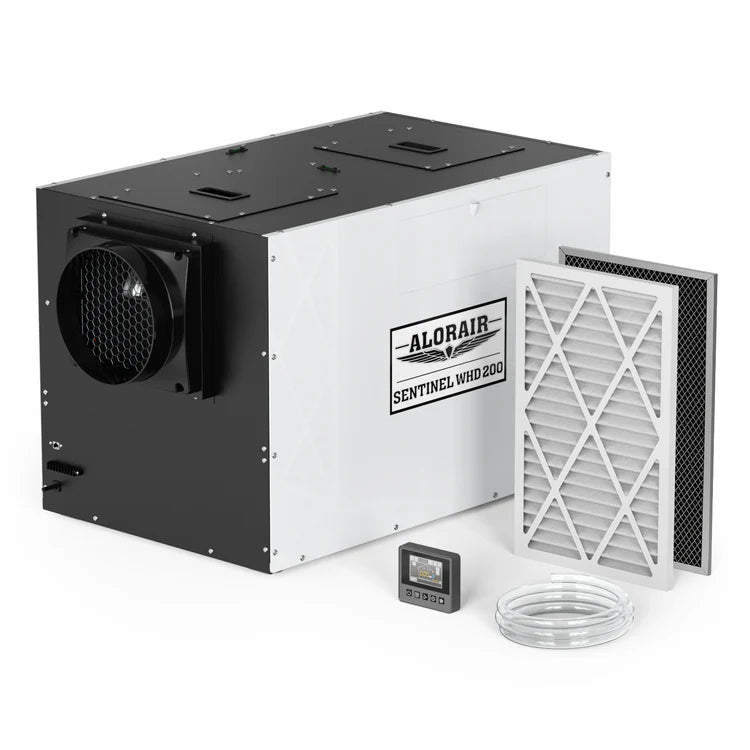
Very large homes (~4,500 sq ft+), or tough environments (coastal, slab with moisture, multi-story homes, high occupant/multipurpose loads).
Key Specs & Highlights:
- Rated up to ~165 pints/day (AHAM) and ~140 pints/day (DOE) for coverage up to ~4,500 sq ft.
- Airflow of ~413 CFM, and large unit size.
Advantages:
- Top tier capacity—handles largest homes or toughest moisture challenges.
- Future-proof for expansion or multiple zones.
- Less likely to struggle under load, meaning possibly quieter and more stable operation.
- Good choice if you already have moisture issues (wet slab, crawlspace, etc.) and need a serious system.
Disadvantages:
- Most expensive.
- Largest physical size—needs significant space for installation, service, and possibly stronger structural support.
- If your home is not that large or not that challenged by moisture, you may never engage full capacity, so you might not get “bang for your buck” compared to smaller unit.
Final Verdict:
If you live in a large home (~4,000-4,500+ sq ft) and have high humidity risk (coastal, many windows, slab or crawl moisture sources) then WHD 200 is a premium choice. For typical mid-sized homes it likely exceeds what’s needed.
How to Choose Between Them
When deciding which model fits you best, consider the following factors (in addition to square footage):
- Climate & humidity load: If you live in a hot/humid region or near coast, step up.
- Home envelope quality: If your home has many leaks, older windows, open ducts, choose higher capacity.
- Moisture sources: Crawl space, basement, indoor plants, pools, or many bathrooms raise load.
- Duct system & placement: Larger units require good airflow paths, lower static, good duct integration.
- Budget & physical space: Bigger units cost more and need more space. Choose the “smallest that works well” rather than “largest just in case.”
Summary Table
|
Model |
Recommended Size |
Capacity |
Strengths |
Trade-Offs |
|
WHD 100 |
Up to ~2,300 sq ft |
~90 pints/day |
Right-sized, budget friendly |
May be tight in leaky or humid homes |
|
WHD 120 |
Up to ~3,000 sq ft |
~104 pints/day |
Margin for comfort, good value |
Slightly higher cost than base model |
|
WHD 150 |
Up to ~3,500 sq ft |
~140 pints/day |
Great for larger homes, higher load |
Higher cost, larger footprint |
|
WHD 200 |
Up to ~4,500 sq ft+ |
~165 pints/day |
Top capacity, future-proof |
Premium price, may be overkill |
Explore Best Dehumidifiers We tested!
The Best Ductless Approach (When You Can’t Tie Into HVAC)

Sometimes ducts are hard to reach, or you may be renovating and want a simpler run. A ductless whole-house arrangement uses a dedicated return grille feeding the dehumidifier and a supply grille into a central area such as a downstairs hallway. You still get true dehumidification, and with good placement, dry air mixes well. This approach works especially well in smaller homes or open-plan main levels. Pick WHD 100 or WHD 120 for most ductless installs and position grilles where air can travel.
The Best HVAC-Ready Layout (What Pros Prefer)

The preferred method is a dedicated return to the dehumidifier and a tie-in to the supply plenum downstream of the AC coil. Dry air then blends before the first branch. This keeps static pressure reasonable and avoids drying across the cold coil where water could re-evaporate. It also lets the dehumidifier run independently, so you don’t need to turn the AC blower on every time it calls. If space is tight and you must supply to the HVAC return, program controls to run the blower whenever the dehumidifier runs so dry air distributes through the home.
What to Look For Beyond Capacity
Airflow and mixing. Higher CFM helps move dry air through long trunks. Aim for a straight mixing section before the first branch so conditions stay even room-to-room.
Service access. Filters should be easy to change, drains should be reachable, and panels should open without disassembling half the closet. If you’re installing in an attic, always use a secondary drain pan with a float switch.
Drain style. Gravity drain is simplest. If the drain is higher or far away, a small condensate pump solves it. Keep a proper trap, slope lines, and test with water after startup.
Noise and placement. Units live quietly near the air handler. Insulated ducts reduce transmission in finished spaces. If the unit sits over living areas, vibration isolators keep things calm.
Controls. A clear digital set point with optional remote or app is ideal. Set 50% RH as your starting point and adjust 45–55% based on comfort and climate.
Energy use. Energy-efficient units reduce runtime cost when you operate many months of the year. Look for strong performance at the standard test condition and pair with sealing measures, such as a tight envelope and a dry crawl space, so the unit doesn’t work harder than necessary.
Real-World Sizing Examples
A 2,000–2,300 sq ft home with average infiltration and a basement typically suits WHD 100. The unit runs modest cycles during shoulder seasons and holds 50% without needing the AC to cool.
A 2,800–3,100 sq ft home that feels humid in spring storms is a better fit for WHD 120. The added capacity shortens cycles during daily peaks and gives breathing room for laundry and cooking moisture.
A 3,400–3,600 sq ft coastal home with frequent open-window evenings needs WHD 150 to maintain stability. The system can absorb those humidity swings and still coast at a steady set point.
A larger, 4,000–4,500 sq ft multi-story home with a big family and frequent showers will be happiest on WHD 200. It prevents the slow creep above 55–60% that shows up on busy days.
Ducting Notes You’ll Actually Use
Keep runs short and smooth. Use insulated flex or hard pipe. Avoid pushing dry air directly across the AC coil; tie into the supply trunk downstream. Allow a straight section before the first branch so dry air blends into the supply airflow. If you supply to the HVAC return instead, interlock the blower with the dehumidifier so it distributes dry air throughout the home. Always include a proper drain trap, test with water, and protect attic installs with a pan and float switch.
Maintenance That Keeps Performance High
Check the filter each season and replace as needed. Take a look at the drain line at the same time; clean it if you see algae. If you use a condensate pump, test its operation annually. Keep the set point simple. Most homes are ideal at 50% RH. In very dry winters, you might relax a little higher so the unit rests when outdoor air is crisp.
Buying Tips if You’re Still Unsure
Choose the model you can install cleanly. A neat, short duct path with an easy drain will outperform a larger model with awkward routing. If you live in a hot-humid region, step up one size so the unit doesn’t need to run long hours on peak days. If you have a complicated supply trunk with many branches, favor the higher-capacity option for better mixing. If service access is tight, pick the chassis with the easiest filter door and panel layout.
Frequently Asked Questions
What is the best whole-house dehumidifier for most homes?
For many mid-size houses, a 90-pint class model such as WHD 100 balances capacity, airflow, and easy installation. It’s big enough for typical moisture loads without being excessive.
Do I need a ducted setup, or can I go ductless?
Ducted delivers the most even results. If you can’t modify ducts, a ductless approach with a dedicated return and a central supply grille still works well. Focus on placement so dry air can spread.
How do I size correctly without getting lost in specs?
Match the model to your square footage and climate. Around 2,300 sq ft, use the 90-pint class. Around 3,000 sq ft, choose the ~100–110-pint class. Around 3,500 and 4,500 sq ft, step to the ~140 and ~165-pint classes. If your climate is very humid, step up one level.
Is a whole-house dehumidifier worth it if I already have AC?
Yes. AC dehumidifies only during cooling calls. A dehumidifier holds a steady 45–55% RH even when the AC is idle, keeping the house comfortable and protecting finishes year-round.
Where should I install it?
Near the air handler in a basement, utility room, or attic with good service access. Keep the drain simple, add a pan and float switch in attics, and use insulated ducts in unconditioned spaces.
Conclusion
The best whole-house dehumidifier is the one that fits your home’s size, installs neatly with a reliable drain, and is easy to service. If you’re around 2,300 sq ft, WHD 100 is the straightforward pick. At 3,000 sq ft, WHD 120 adds headroom.
For larger homes and humid regions, WHD 150 and WHD 200 provide the capacity and airflow to keep every room steady at your set point. Choose ducted when you can for the most even results, use ductless where access is tight, and set the control at 50% RH to start. A quiet, right-sized system keeps your house dry, comfortable, and protected—season after season.




